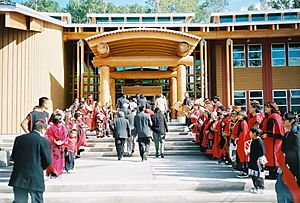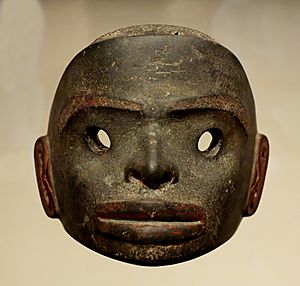Nisga'a facts for kids

Nisga'a community members and officials at the dedication of their new government building in 2000.
|
|
| Total population | |
|---|---|
| 5,495 (2016 census) | |
| Regions with significant populations | |
| Canada (British Columbia) | |
| Languages | |
| English • Nisga'a | |
| Related ethnic groups | |
| Gitxsan |
The Nisga’a are an Indigenous people who live in British Columbia, Canada. They make their homes in the Nass River valley in the northwestern part of British Columbia. The name Nisga'a means 'people of the Nass River'.
The Nisga'a language and English are the official languages of the Nisga'a people.
Contents
Nisga’a Culture and Traditions
Nisga’a Society
Nisga’a society is organized into four main groups, called tribes. Each tribe has many families connected by their history. These tribes are:
- Ganhada (Raven)
- Gispwudwada (Killer Whale)
- Laxgibuu (Wolf)
- Laxsgiik (Eagle)
Within each tribe, there are smaller family groups called "house groups." These are like extended families with shared origins. Sometimes, several house groups with the same ancestors are part of a larger "clan." For example, the Lax̱gibuu Tribe (Wolf Tribe) includes the Gitwilnaak’il Clan, which has house groups like the House of Duuḵ.
Traditional Nisga’a Foods
The Nisga’a people traditionally gather food from the land and sea all year. They collect "beach food" like razor clams, mussels, and oysters from the shore. They also catch salmon, cod, and other fish from streams. Hunting is also important, with seals, fish, and sea lions from the water, and mountain goats and birds from the forests.
A special food is the grease from the oolichan fish. It was often traded with other tribes. Today, this trade is usually part of special ceremonies. Families work together to cook and prepare food, often roasting or boiling meat and fish. Fish and sea mammals are eaten frozen, boiled, dried, or roasted.
Nisga’a Traditional Homes
Traditional Nisga’a homes were large, rectangular buildings. They were made from cedar planks, with roofs also made of cedar. The doors usually faced the water and were decorated with the family's special crest.
Inside, the floor was dug lower to help keep the house warm and hold the hearth (fireplace). Beds and storage boxes were placed along the walls. Long ago, three or four extended families might live in one house. Today, this is not common. Masks and blankets often decorated the walls.
Traditional Nisga’a Clothing
Before Europeans arrived, Nisga’a men often wore very little in the summer, which was the best time for hunting and fishing. Women wore skirts made from soft cedar bark.
In colder weather, men wore cedar bark skirts (like a loincloth), a cedar bark cape, and a basket hat when outside in the rain. Inside, they might wear nothing. Women wore basket hats and cedar blankets both indoors and outdoors. Both men and women made and wore necklaces from shells and bones. They would rub seal blubber into their hair, and men often kept their hair long or tied in a knot on top of their heads.
During times of war, men wore armor made of red cedar, a cedar helmet, and cedar loincloths. They used spears, clubs, harpoons, bows, and slings. Woven shields were also common for protection.
Nisga’a Communities
Around 2,000 Nisga’a people live in the Nass River Valley. Another 5,000 Nisga’a live in other parts of Canada, mostly in bigger cities.
Nisga’a Villages
The Nisga’a Nation has about 7,000 people in total. In British Columbia, the Nisga’a Nation is represented by four main villages:
- Gitlaxtʼaamiks (once called New Aiyansh) – home to nearly 800 people.
- Gitwinksihlkw (once called Canyon City) – with about 200 people.
- Lax̱g̱altsʼap (once called Greenville) – with more than 500 people.
- Ging̱olx (once called Kincolith) – with almost 400 people.
Nisga’a in Cities
Many Nisga’a people have moved to cities to find more opportunities. Large groups of Nisga’a live in three main cities outside their traditional territory:
- Terrace
- Prince Rupert/Port Edward
- Vancouver – about 1,500 Nisga’a live in Vancouver, and others live in the surrounding Lower Mainland area.
Nisga’a Calendar and Life
The traditional Nisga’a calendar follows the cycles of the moon and the harvesting of foods and goods. Each month has a special meaning related to nature.
- Hobiyee: This means "Like a Spoon" and happens in February or March. It's the traditional time to celebrate the new year.
- X̱saak: This means "To Eat Oolichan" and is in March. Oolichan fish return to the Nass River then. They are the first food harvested after winter, marking the start of the harvesting year.
- Mmaal: This means "To Use Canoes Again" and is in April. The ice on the river starts to break, so canoes can be used.
- Yansa’alt: This means "Leaves Are Blooming" and is in May, when leaves grow again.
- Miso’o: This means "Sockeye Salmon" and is in June, when sockeye salmon are harvested.
- X̱maay: This means "To Eat Berries" and is in July, when various berries are picked.
- Wii Hoon: This means "Great Salmon" and is in August, when large amounts of salmon are harvested.
- Genuugwiikw: This means "Trail of the Marmot" and is in September, when small animals like marmots are hunted.
- X̱laaxw: This means "To Eat Trout" and is in October, when trout is a main food.
- Gwilatkw: This means "To Blanket" and is in November, when snow covers the earth.
- Luut’aa: This means "To Sit" and is in December, referring to the sun staying low in the sky.
- Ḵ’aliiyee: This means "To Walk North" and is in January, when the sun starts to move north again.
- Buxwlaks: This means "To Blow Around" and is in February, referring to the strong winds during this time.
Nisga’a Treaty
On August 4, 1998, the Nisga’a people, the government of British Columbia, and the Government of Canada signed an important agreement. This agreement officially recognized nearly 2,000 square kilometers (about 770 square miles) of land in the Nass River valley as Nisga’a territory. It also created a water reservation. Bear Glacier Provincial Park was also created because of this agreement.
This was the first modern treaty signed by a First Nation in British Columbia since the 1800s. It was a big step for the Nisga’a people to regain control over their traditional lands.
Nisga’a History
Long ago, in the 18th century, a volcano called the Tseax Cone erupted. It was in a valley above the Ksi Sii Aks (Tseax River). This eruption released poisonous gases that sadly killed about 2,000 Nisga’a people.
Nisga’a Government
The Nisga’a people have their own government bodies. These include the Nisga’a Lisims Government, which is the main government for the Nisga’a Nation. There are also Nisga’a village governments, one for each of the four Nisga’a villages. The Nisga’a Lisims Government building is located in Gitlaxt'aamiks.
The Nisga’a Lisims Government has leaders who work to manage the Nisga’a Nation. For example, Eva Clayton is the President, and Charles Morven is the Secretary-treasurer. There are also chief councillors for each village and representatives for Nisga’a people living in cities like Vancouver and Terrace.
Nisga’a Museum
In 2011, the Nisg̱aʼa Museum opened in Lax̱g̱altsʼap. This museum was created by the Nisga’a Lisims Government. It holds many historical items and artifacts that belong to the Nisga’a people. Many of these items were returned to the Nisga’a after being in other museums for many years.
Well-Known Nisga’a People
Here are some notable Nisga’a individuals:
- Jordan Abel, a poet.
- Frank Arthur Calder, a hereditary chief, treaty negotiator, and important leader who worked for Nisga’a rights.
- Joseph Gosnell, a hereditary chief and treaty negotiator, who also served as a former President of the Nisga’a Lisims Government.
- Norman Tait, a hereditary chief and a master carver.
- Ron Telek, a talented carver.
- Larry McNeil, a photographer with Tlingit and Nisga’a heritage.
- Da-ka-xeen Mehner, a photographer and artist with Tlingit and Nisga’a heritage.
See also


